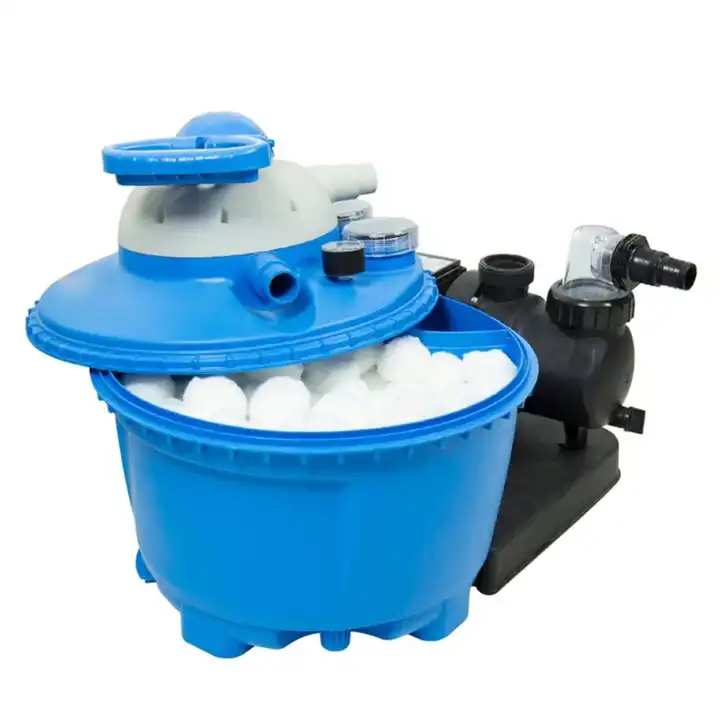In pool maintenance, the filtration system plays a crucial role, and spherical filters are widely used in many pools as a common choice. However, over time, these filters may encounter various issues, affecting the pool’s water quality and cleanliness. Therefore, understanding how to identify and rectify pool filter problems is essential. This article will explore common problem signs, solutions, and preventive measures to help ensure the effective operation of pool filtration systems.
Ⅰ. Introduction to Pool Filter Balls
A. The Role and Principle of Pool Filter Balls
Pool filter balls are a new type of pool filtration medium, typically made of high-quality polyester fibers. These spherical filtration media feature a micro-porous structure, effectively filtering impurities and contaminants from pool water. Their working principle is similar to traditional sand filters, but their micro-pores are smaller, allowing for more efficient capture and filtration of tiny particles, thus providing cleaner and clearer pool water.
B. The Importance of Pool Filter Balls in Pool Maintenance
Pool filter balls play a crucial role in pool maintenance. Firstly, they effectively remove pollutants and impurities from water, including sediment, leaves, insects, bacteria, and microorganisms, thereby maintaining water quality. Secondly, pool filter balls have a longer lifespan and lower maintenance costs compared to traditional sand filters, making them more durable and cost-effective. Additionally, they improve the efficiency of pool filtration systems, reducing energy consumption and providing pool owners with a more economical and environmentally friendly option. In summary, pool filter balls play an indispensable role in pool maintenance, providing pool owners with a clean and healthy water environment.
Ⅱ. Identifying Pool Filter Ball Issues
Common Signs and Symptoms of Problems
- Water Quality Issues:
- Water becomes cloudy and opaque.
- Unusual colors in water, such as green, yellow, or brown.
- Presence of floating debris or suspended particles.
- Flow Issues:
- Slow circulation speed of pool water.
- Abnormal noise from the water pump, such as noise or strange sounds.
- Significant slowdown in the inflow of pool water into the filtration system.
- Decrease in Pool Cleanliness:
- Dirt and stains on the bottom and surface of the pool.
- Scale or water lines appearing on the pool edge.
- Coatings or biological growth on pool walls and pipe surfaces.

Ⅲ. Resolving Pool Filter Ball Issues
A. Cleaning Pool Filter Balls
Step 1: Remove the Filter Balls
- Turn off the pool pump and filtration system.
- Open the drain valve of the filter to drain the water.
- Carefully remove the filter balls by opening the filter cover.
Step 2: Clean the Filter Balls
- Use a soft brush or hose to clean the surface of the filter balls, removing attached dirt and debris.
- Soak the filter balls in a mixture of cleaning agent, following the instructions for soaking and cleaning to ensure thorough removal of dirt.
Step 3: Rinse and Dry
- Thoroughly rinse the filter balls with clean water to ensure that the cleaning agent and dirt are completely washed away.
- Place the filter balls in a well-ventilated area to air dry, ensuring they are completely dry.
B. Replacing Filter Balls
- When to Replace
- When the surface of the filter balls cannot be restored to smoothness through cleaning, or when severe damage, deformation, or discoloration occurs, replacement should be considered.
- If water quality or flow issues persist after cleaning and other possible causes have been ruled out, replacement of the spherical filter may be necessary.
- Replacement Steps and Precautions
- Select the appropriate filter balls based on the model and specifications of the pool filter.
- Turn off the pool pump and filtration system to drain the water from the filter.
- Open the cover of the filter and carefully remove the old filter balls.
- Place the new spherical filter in the filter and ensure proper installation and stable positioning.
- Close the cover of the filter to ensure a good seal.
- Turn on the pool pump and filtration system, check if the spherical filter is working properly, and observe the flow and water quality.
- Regularly check the status of the spherical filter and clean or replace it as needed to maintain the normal operation of the pool filtration system.
C. Using Filter Balls to Improve Pool Circulation Efficiency
In some cases, the circulation of an old pool may be insufficient, which may be due to various factors such as collapsed or capped old main drainage pipes, dirty filters or pump baskets, and pool cleaners that increase filter pressure, slowing down water flow and hindering the expected circulation pattern and flow rate. To improve pool circulation efficiency, the following measures can be taken:
- Adding Skimmer Socks: Stretch skimmer socks over the top of the skimmer basket to capture large, small, and fine debris before they enter the pool system.
- Filling Skimmer Baskets with Filter Balls: Place filter balls in the skimmer basket to capture debris, especially before reaching the filter.
- Using Pool Clarifiers: Use a pool clarifier to help particles gather for easier removal from the filter when the filter’s lifespan is nearing its end.
In pool maintenance, timely identification and rectification of pool filter ball issues are crucial. By regularly inspecting and maintaining your filters, you can ensure clean pool water and prolong the lifespan of the filtration system. Remember, addressing issues promptly can prevent more serious consequences, so keep a close eye on the status of your pool filter balls and take appropriate action as needed.
